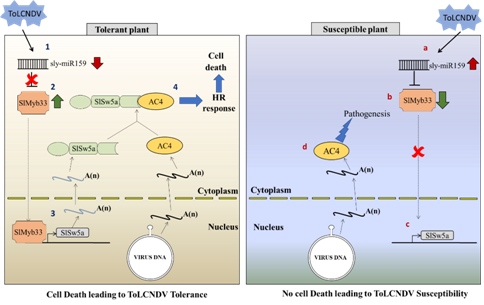Ministry of Science & Technology
Effective defense strategy deployed by a resistant tomato cultivar against Tomato leaf curl New Delhi virus unravelled by scientists of National Institute of Plant Genome Research
Posted On:
16 AUG 2021 5:15PM by PIB Delhi
Tomato leaf curl New Delhi virus (ToLCNDV) infection causes severe losses in tomato yield worldwide. Lack of information on resistance (R) genes against ToLCNDV has considerably retarded the pace of crop improvement against this rapidly spreading pathogen. Several attempts have been made to identify antiviral genes against ToLCNDV and related viruses. Scientists from DBT Autonomous Institution, National Institute of Plant Genomics Research (NIPGR) report an effective defense strategy deployed by a resistant tomato cultivar against ToLCNDV. It employs Sw5a (R gene) that recognizes AC4 protein (viral effector) of ToLCNDV to restrict virus spread. At the transcriptional level, the sly-miR159-SlMyb33 module has been identified as governing gene expression of Sw5a. Thus, the investigators have provided a mechanistic insight into slymiR159-SlMyb33–controlled Sw5a-mediated defense response in tomato against ToLCNDV. These findings could be translated into development of resistance in susceptible cultivars of tomato through modern breeding or molecular approaches. This work was published in Proceeding of the National Academy of Sciences (PNAS August 17, 2021 118 (33) e2101833118; https://doi.org/10.1073/pnas.2101833118)

Figure legend: Schematic representation of sly-miR159-SlMyb33 complex in providing resistance against ToLCNDV. In the resistant cultivar H-88-78-1, sly-miR159 gets down-regulated upon virus infection (1), therefore restricting the degradation of SlMyb33 mRNA and causing increased expression of SlMyb33 (2). SlMyb33 further binds onto the promoter region of SlSw5a and induces the expression (3). Moreover, SlSw5a interacts with virus protein AC4 (pathogenesis determinant) and triggers Hypersensitive (HR) response in the ToLCNDV infiltrated regions and limits the spread of virus (4). On the contrary in the susceptible cultivar Punjab Chhuhara, up-regulation of sly-miR159 (a) inhibits the expression of SlMyb33 (bThis restricts the binding of SlMyb33 on the promoter of SlSw5a, therefore, suppressing the expression of SlSw5a and HR (c). This leads to virus infection in the plant (d).
Dr.RenuSwarup, Secretary DBT congratulated Dr. Manoj Prasad and his team for this important piece of work which can be applied to improve the yield of tomato crop. Dr.Swarup also commented that the Department of Biotechnology has taken several initiatives in Agriculture Biotechnology in line with the Hon’ble Prime Ministers vision of doubling of farmers’ income by year 2022.
<><><><><>
SNC/TM/RR
(Release ID: 1746403)
Visitor Counter : 2095